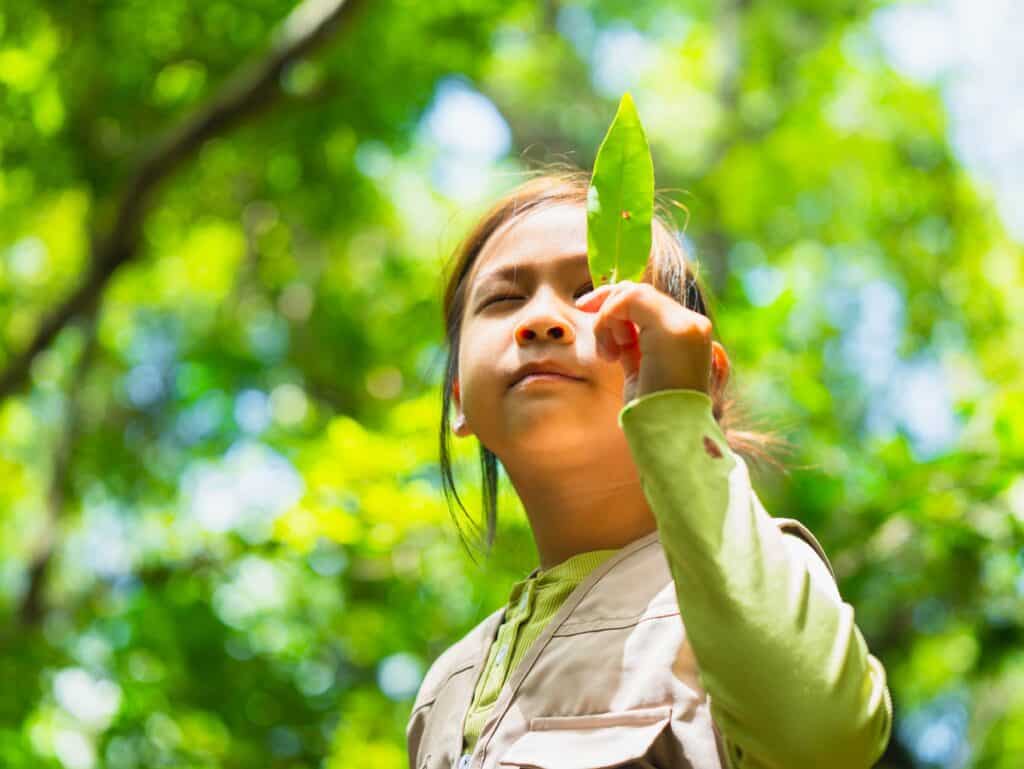Natural Links Incursion
-
Food Webs
-
Human Impacts
-
Living things
-
Species Interactions



Program Overview
Planet Earth is a complex environment that relies on delicate links and sophisticated relationships. This 90 program with 3 modules, gives students the opportunity to classify natural objects, explore the biodiversity around your school, understand the complexity of food webs and learn about human impacts, so we can identify positive actions we can all take at home and at school to create happy, healthy environments and communities to live, work and play.
This program can be tailored to suit different levels of understanding, from topic introduction to topic consolidation. Topics include:
Classification
All living things are connected to one another for survival, like the clownfish that lives in a sea anemone for protection from predators or simple relationships like birds eating seeds from plants. Living things also rely on non-living parts of their habitat, such as trees needing sunlight, water and carbon-dioxide to make their food. Students learn how to tell the difference between living and non-living things in a habitat and the relationships that link them together. They are also introduced to the concept of classification and be able to recognise the difference between living, once living, the product of a living thing and non-living things. Advanced students can also explore how scientists classify living things.
Fragile Food Webs
This activity allows students to examine the complex relationships in nature across three continents during an interactive food web game. By the end of this module, students should be able to explain the difference between food chains and food webs. Students will discover the feeding relationships between living things within food webs and how these relationships can be affected by human activities.
Habitats and Survival (Mini Beasts, Plants and Birds)
Students get to do a biodiversity audit as they explore the different habits in the school grounds. They get to identify and collect (where safe to do so) as many different species as possible in collection containers, so under magnification they can identify their different characterises and consider what they are and what they need to survive. By the end of this module, students will understand that we share our local habitats with many different species, each of which plays an important role in keeping the environment balanced. Students will also discover the different lifecycles of some common invertebrates.
Humans Impacts & Call to Action
Discuss how human activities can affect and/or disrupt natural links within the environment and let your students determine actions they can adopt to minimise their impact on the environment.
Duration: 1.5 hours
Inclusions and Notes
Certificate and Conservation Code to reinforce learnings
Post event, schools will be issued a Certificate of Participation and Conservation Code for each class which students are encouraged to sign and hang in the classroom as a reminder of their learnings and their commitment to protect the environment.
We encourage schools to connect with us a few weeks or months after school excursions to share behaviour changes made by the students or activities undertaken as a result of their learnings during their program so we can share success stories to inspire others, monitor the ongoing impact of our programs and make relevant updates or changes if required.
Restrictions: Program timing considerations: Staff require 10-minutes between groups to reset activities and a 30-minute break for lunch when more than 2 groups are booked. Available to Melbourne Metro area only.
What to Provide: Multi-purpose room, floor space, whiteboard
Curriculum Links
Science Understanding: Science as a Human Endeavour
Science knowledge helps people to understand the effects of their actions (VCSSU056)
Science Understanding: Biological Science
Living things have characteristics that distinguish them from non-living things and things that were once living, including fossils VC2S4U01
Plants and animals have different life cycles; offspring are similar, but not identical, to their parents VC2S4U02
Consumers, producers and decomposers have different roles and interactions within a habitat; food chains can be used to represent feeding relationships VC2S4U03
Science Understanding: Earth and Space Science
Water is an important Earth resource that originates from various sources; water cycles through the environment by moving through the sky, landscape and ocean, and involves processes including precipitation, evaporation, transpiration, condensation, melting, freezing, crystallisation, infiltration and run-off VC2S4U07
Science Inquiry: Processing, modelling and analysing
Data and information can be organised and represented to identify patterns and simple relationships by constructing tables, graphs and visual or physical models VC2S4I04
Sciency Inquiry: Questioning and predicting
Observations can be used as a basis for posing questions to identify patterns and relationships, and to predict the outcomes of investigations VC2S4I01
Geographical Knowledge | Diversity of places and environments
The relationships between people and their place and its environment VC2HG4K01
The importance of environments, including natural vegetation and water sources, to people and animals in Australia and on another continent VC2HG4K03
Sustainability and its application to the use of natural resources and the management of waste VC2HG4K09
Geographical Skills – Geographical Inquiry
identify and develop questions to guide a geographical inquiry on the diversity of places and environments VC2HG4S01
locate, collect and record information and data from a range of sources, including from fieldwork, maps, photographs and graphs VC2HG4S02
Represent and analyse information and data collected in different formats VC2HG4S03
Citizenship Knowledge and Understanding: Diversity and Understanding
Why people participate within communities and how students can actively participate and contribute to communities VC2HC4K07
English: Language for interacting with others
Understand that cooperation with others depends on shared understanding of social conventions, including turn-taking language, which vary according to the degree of formality VC2E3LA01
English: Literacy Interacting with others
Use interaction skills to contribute to conversations and discussions to share text- or topic-based information and ideas VC2E3LY01
Drama: Creating
Use a variety of dramatic forms and elements of drama to create real and imagined stories VC2ADR2C01
Drama: Presenting
Present and share drama that communicates ideas to audiences in informal settings VC2ADR2P01
The Victorian Curriculum F-10 content elements are © VCAA, reproduced by permission. Victorian Curriculum F-10 elements accurate at time of publication. The VCAA does not endorse or make any warranties regarding this resource. The Victorian Curriculum F-10 and related content can be accessed directly at the VCAA website.
